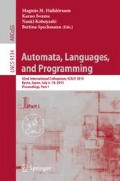Abstract
What is the value of input information in solving linear programming? The celebrated ellipsoid algorithm tells us that the full information of input constraints is not necessary; the algorithm works as long as there exists an oracle that, on a proposed candidate solution, returns a violation in the form of a separating hyperplane. Can linear programming still be efficiently solved if the returned violation is in other formats?
Motivated by some real-world scenarios, we study this question in a trial-and-error framework: there is an oracle that, upon a proposed solution, returns the index of a violated constraint (with the content of the constraint still hidden). When more than one constraint is violated, two variants in the model are investigated. (1) The oracle returns the index of a “most violated” constraint, measured by the Euclidean distance of the proposed solution and the half-spaces defined by the constraints. In this case, the LP can be efficiently solved (under a mild condition of non-degeneracy). (2) The oracle returns the index of an arbitrary (i.e., worst-case) violated constraint. In this case, we give an algorithm with running time exponential in the number of variables. We then show that the exponential dependence on n is unfortunately necessary even for the query complexity. These results put together shed light on the amount of information that one needs in order to solve a linear program efficiently.
The proofs of the results employ a variety of geometric techniques, including the weighted spherical Voronoi diagram and the furthest Voronoi diagram.
Access this chapter
Tax calculation will be finalised at checkout
Purchases are for personal use only
Preview
Unable to display preview. Download preview PDF.
References
Ash, P.F., Bolker, E.D.: Recognizing dirichlet tessellations. Geometriae Dedicata 19(2), 175–206 (1985)
Bei, X., Chen, N., Zhang, S.: On the complexity of trial and error. In: Proceedings of the 45th ACM Symposium on Theory of Computing, pp. 31–40 (2013)
Bei, X., Chen, N., Zhang, S.: Solving linear programming with constraints unknown (2013). arXiv:1304.1247
Chiang, M., Hande, P., Lan, T., Tan, C.-W.: Power control in wireless cellular networks. Foundations and Trends in Networking 2(4), 381–533 (2007)
Clarkson, K.L.: Las vegas algorithms for linear and integer programming when the dimension is small. Journal of the ACM 42(2), 488–499 (1995)
Doherty, L., Pister, K., Ghaoui, L.E.: Convex position estimation in wireless sensor networks. In: Proceedings of the Twentieth IEEE Annual Joint Conference of the IEEE Computer and Communications Societies (INFOCOM), pp. 1655–1663 (2001)
Dyer, M., Megiddo, N., Welzl, E.: Linear programming. In: Goodman, J.E., O’Rourke, J. (eds.) Handbook of Discrete and Computational Geometry. CRC Press (2004)
Dyer, M.E.: On a multidimensional search technique and its application to the euclidean one-centre problem. SIAM Journal on Computing 15(3), 725–738 (1986)
Foschini, G.J., Miljanic, Z.: A simple distributed autonomous power control algorithm and its convergence. IEEE Transactions on Vehicular Technology 42(3), 641–646 (1993)
Gentile, C.: Distributed sensor location through linear programming with triangle inequality constraints. In: Proceedings of IEEE Conference on Communications, pp. 3192–3196 (2005)
Grötschel, M., Lovász, L., Schrijver, A.: Geometric methods in combinatorial optimization. In: Progress in Combinatorial Optimization, pp. 167–183 (1984)
Grötschel, M., Lovász, L., Schrijver, A.: Geometric Algorithms and Combinatorial Optimization. Springer (1988)
Hartvigsen, D.: Recognizing voronoi diagrams with linear programming. INFORMS Journal on Computing 4(4), 369–374 (1992)
Ivanyos, G., Kulkarni, R., Qiao, Y., Santha, M., Sundaram, A.: On the complexity of trial and error for constraint satisfaction problems. In: Esparza, J., Fraigniaud, P., Husfeldt, T., Koutsoupias, E. (eds.) ICALP 2014. LNCS, vol. 8572, pp. 663–675. Springer, Heidelberg (2014)
Kalai, G.: A subexponential randomized simplem algorithm. In: Proceedings of the ACM Symposium on Theory of Computing (STOC), pp. 475–482 (1992)
Khachiyan, L.: A polynomial algorithm in linear programming. Doklady Akademii Nauk SSSR 244, 1093–1096 (1979)
Kovalev, M.: A property of convex sets and its application. Matematicheskie Zametki, pp. 89–99. English translation: Mathematical Notes, 44, 537–543 (1988)
Matousek, J., Sharir, M., Welzl, E.: A subexponential bound for linear programming. Algorithmica 16(4/5), 498–516 (1996)
Megiddo, N.: Linear programming in linear time when the dimension is fixed. Journal of the ACM 31(1), 114–127 (1984)
Montgomery, D.: Design and Analysis of Experiments, 7 edn. Wiley (2008)
Papadimitriou, C.H., Steiglitz, K.: Combinatorial Optimization: Algorithms and Complexity. Dover Publications (1998)
Papadimitriou, C.H., Yannakakis, M.: Linear programming without the matrix. In: Proceedings of the ACM Symposium on Theory of Computing (STOC), pp. 121–129 (1993)
Ryzhov, I.O., Powell, W.B.: Information collection for linear programs with uncertain objective coefficients. SIAM Journal on Optimization 22(4), 1344–1368 (2012)
Sandgren, L.: On convex cones. Mathematica Scandinavica 2, 19–28 (1954)
Yudin, D.B., Nemirovskii, A.S.: Informational complexity and efficient methods for the solution of convex extremal problems. Ekonomika i Matematicheskie Metody, 12, 357–369 (1976). English translation: Matekon 13(3), 25–45 (1977)
Author information
Authors and Affiliations
Corresponding author
Editor information
Editors and Affiliations
Rights and permissions
Copyright information
© 2015 Springer-Verlag Berlin Heidelberg
About this paper
Cite this paper
Bei, X., Chen, N., Zhang, S. (2015). Solving Linear Programming with Constraints Unknown. In: Halldórsson, M., Iwama, K., Kobayashi, N., Speckmann, B. (eds) Automata, Languages, and Programming. ICALP 2015. Lecture Notes in Computer Science(), vol 9134. Springer, Berlin, Heidelberg. https://doi.org/10.1007/978-3-662-47672-7_11
Download citation
DOI: https://doi.org/10.1007/978-3-662-47672-7_11
Published:
Publisher Name: Springer, Berlin, Heidelberg
Print ISBN: 978-3-662-47671-0
Online ISBN: 978-3-662-47672-7
eBook Packages: Computer ScienceComputer Science (R0)

